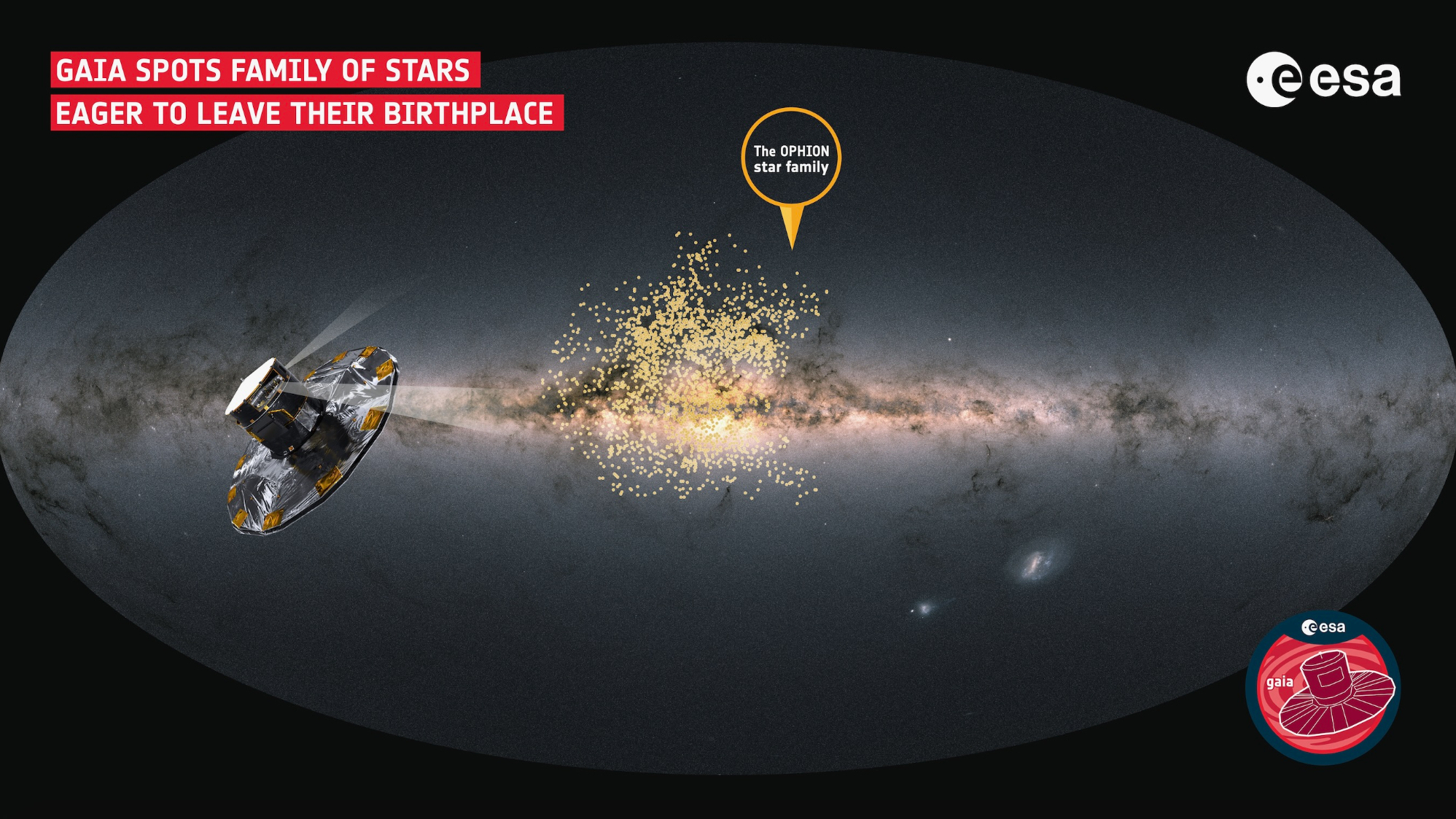A huge family of newborn stars seem to now be going their separate ways: Over 1,000 stars are hurriedly fleeing their nest in record time, leading to something of a mystery as to the cause of this stellar breakup.
Typically it takes a few hundred million years for a cluster of stars that are born together to break up, gradually nudged apart by gravitational tidal forces from each other and other passing objects. For example, the famous Pleiades star cluster (Messier 45), which is a tight grouping of young stars visible to the naked eye in the constellation of Taurus, the Bull, is 100 million years old, while the Beehive Cluster (Messier 44) in Cancer, the Crab, is around 600 million years old (and a little more dispersed than the Pleiades).
Yet a newly discovered young open cluster of stars, barely 20 million years old, seems to be playing by a different set of rules. Using data from the European Space Agency's Gaia mission, which measured the position, velocity, distance and spectra of approximately two billion stars, astronomers led by Dylan Huson of Western Washington University found that the thousand stars of this new cluster are all moving too fast to stay together.
The cluster is about 650 light-years away in Ophiuchus, the Serpent Bearer, and has been nicknamed "Ophion" in honor of its resident constellation.
"Ophion is filled with stars that are set to rush out across the galaxy in a totally haphazard, uncoordinated way, which is far from what we'd expect for a family so big," said Huson in a statement. "What's more, this will happen in a fraction of the time it'd usually take for such a large family to scatter. It's like no other star family we've seen before."
The range of velocities in a star cluster is known as its velocity dispersion. Because giant molecular clouds that give birth to stars are cold, they have low energy and therefore low velocity dispersions of just a few kilometers per second, which they should pass on to their fledgling stars.
This means that the stars of a cluster should all be moving at more or less the same low velocity, which allows their mutual gravity to keep a hold of them for longer. The velocity dispersion in Ophion, as measured by Gaia, is much larger than normal, at 20 kilometers (12.4 miles) per second. In other words, the difference between the fastest and slowest moving stars in Ophion is 20 kilometers per second.
With such a high velocity dispersion, Ophion will quickly fly apart. The only reason we see these stars together at the moment is because they are so young and they haven't had the chance to separate yet.
"We don't know exactly what happened to this star family to make it behave this way, as we haven't found anything quite like it before," said Marina Kounkel of the University of North Florida, who was part of the discovery team. "It's a mystery."
The existence of Ophion was not immediately obvious. Huson and Kounkel's team were testing a new model, called Gaia Net, which can simultaneously analyze the spectra of millions of stars, when the cluster popped out of the data.
"This is the first time it's been possible to use a model like this for young stars, due to the immense volume and high quality of spectroscopic observations needed to make it work," said Johannes Sahlmann, Gaia project scientist at the European Space Agency. "It's still pretty new to be able to reliably measure the parameters of lots of young stars at once. This kind of bulk observing is one of Gaia's truly unprecedented achievements."
So, what has led Ophion's stars to head out on their own trajectories in such a hurry so early in their life? While scrutinizing the Gaia data, Huson's team noticed several large voids — areas where supernova shockwaves have blown away the interstellar gas. Astronomers call these voids "superbubbles," and it's possible that much of the remaining gas in Ophion following the formation of its stars was blown away too by the stellar blast waves. Losing so much mass in the guise of all this gas had a feedback effect, loosening the cluster's hold on its stars. Gravitational tidal effects from the mass of neighboring star-forming regions could also have given Ophion's stars an extra push.
"Excitingly, it changes how we think about star groups and how to find them. Previous methods identified families by clustering similarly moving stars together, but Ophion would have slipped through this net," said Kounkel. "Without the huge, high-quality datasets from Gaia, and the new models we can now use to dig into these, we may have been missing a big piece of the stellar puzzle."
So there may be other young families of stars out there racing apart. Our view of Ophion is like a photograph of a young adult just before they leave home for college. They're on their way, but haven't quite left the nest just yet. Where these stars will end up is anyone's guess, but they are destined to wander the space lanes alone.
Huson's team lays out the Gaia Net model in a new study, which was published April 25 in The Astrophysical Journal.








 English (US) ·
English (US) ·